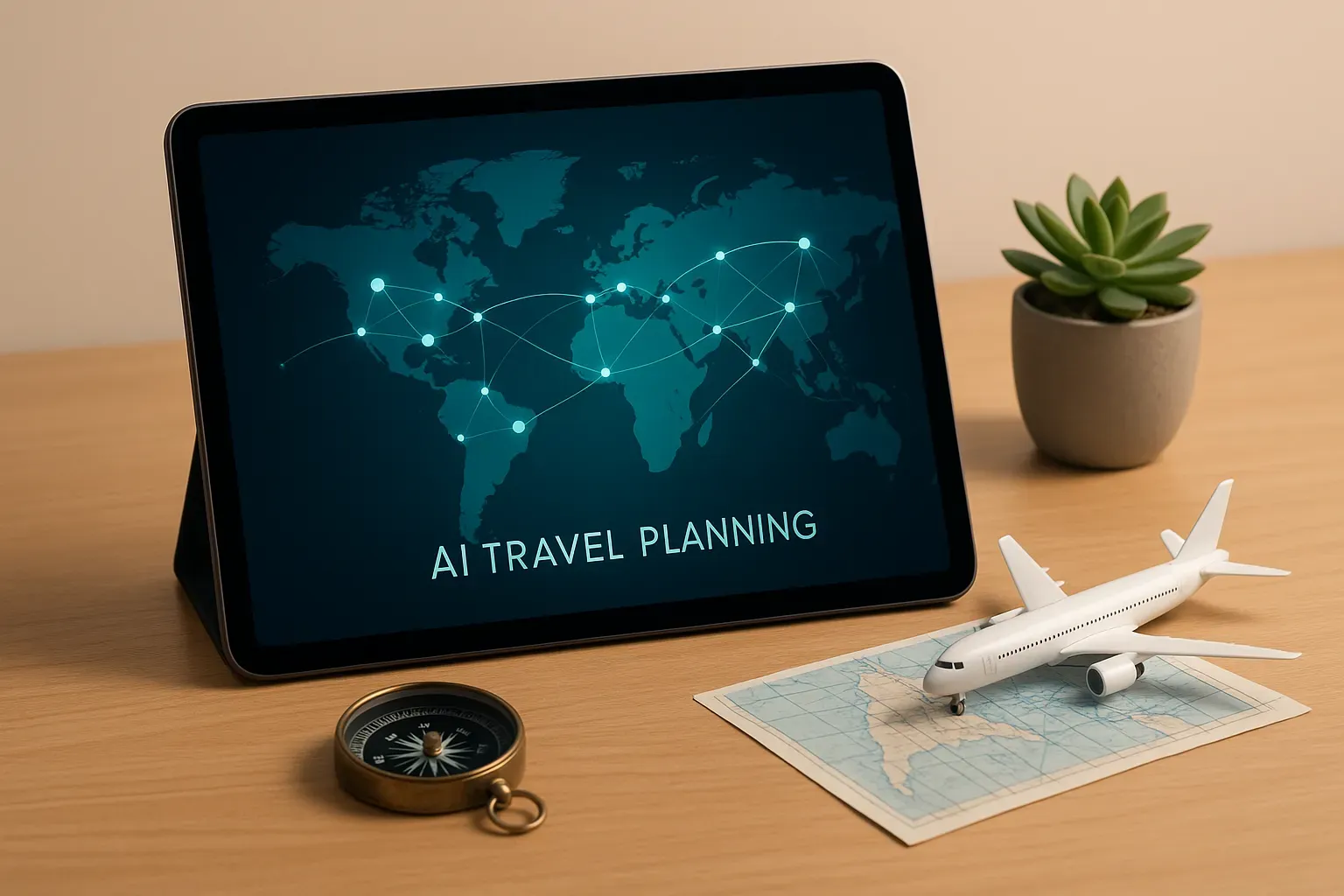Travel planning with AI tools is transforming how first-time users organize trips, offering streamlined approaches that blend technology with personal preferences. Industry experts reveal essential strategies for effectively communicating with AI platforms to create optimized itineraries while maintaining human decision-making control. These practical techniques help travelers leverage artificial intelligence for handling logistics while focusing on the meaningful experiences that make journeys memorable.
- Send Booking Details First Before Asking Questions
- Pair AI Inspiration With Travel Advisor Expertise
- AI Handles Logistics While Humans Find Magic
- Treat AI Like a Conversational Travel Agent
- Start With Your Why When Planning Travel
- Use AI to Draft Plans Not Make Decisions
- Research Correct Prompts for Trip Organization
- Define Goals Before Using Travel Platforms
- Feed AI Specific Details for Better Itineraries
- Stress Test Your Itinerary With AI
Send Booking Details First Before Asking Questions
I’ve spent a dozen years marketing tours and have seen plenty of first-time AI trip-planners.
New users often throw big, vague questions at a chatbot and then wonder why the answers feel off. If you’re going to use AI, what you should do is first send every booking email (flights, hotels, tours, and so on) to a site like TripIt. It will sort the dates and times for you so you have a tidy, error-proof timeline to give the AI. Now, open Perplexity AI (or ChatGPT, Bard, etc.) and ask what to add around the locked-in details you gave it. Because it can see the who/where/when, its suggestions aren’t things like fitting Paris and Porto into the same afternoon. It will give you train rides that actually exist or day trip activities that can actually fit in a day.

Pair AI Inspiration With Travel Advisor Expertise
If you’re using AI for travel planning for the first time, my advice is to treat it as your brainstorming buddy rather than your final decision-maker. AI tools are fantastic at generating ideas, like suggesting itineraries, destinations based on a few of your likes and dislikes, or giving you a sense of what’s possible. However, it can sometimes miss the nuances of your preferences, the fine print of promotions, or the ever-changing policies of airlines and resorts.
That’s where working with a travel advisor makes all the difference. I’d recommend starting with AI tools like ChatGPT or Google’s AI Overviews to get inspiration and help you narrow down what excites you most about your trip. Then, bring those ideas to a travel advisor. We can refine them, add the insider knowledge, handle the logistics, and make sure you don’t miss out on savings, upgrades, or experiences that AI might not catch.
Think of it like this: AI is your spark of inspiration, and your travel advisor is the one who makes it real, stress-free, and magical.

AI Handles Logistics While Humans Find Magic
Here’s my honest take: AI is brilliant for the boring logistics but terrible at understanding what makes a trip magical.
I watched a traveler use ChatGPT to plan her Morocco itinerary — it nailed the basics (Marrakech, Fes, Sahara) but missed the small riad in Essaouira where the owner’s grandmother teaches traditional cooking classes. That’s the difference between checking boxes and truly experiencing a place.
I watched a traveler use ChatGPT to plan her Morocco itinerary — it nailed the basic outline (Casablanca, Fes, Sahara, Marrakech) but missed recommending the unique experiences like a leather slipper workshop or tasting tour of the Fes medina that make the difference between checking boxes and truly experiencing a place.
My advice? Use tools like ChatGPT or Claude for the tedious stuff — comparing flights, explaining visa requirements, or sketching a basic itinerary. AI saves hours by aggregating info you’d otherwise dig up from ten different sites.
But once AI gives you the framework, dig deeper. Explore travel forums, Instagram tags, and companies that really know the destination. When I planned my trip to Oman, AI got the landmarks right but missed which souks actually welcome foreign women or which guides were worth hiring.
Use AI as your research assistant, not your travel agent. It’ll get you 70% of the way there — the last 30% comes from human insight, and that’s what turns a trip from adequate to unforgettable.

Treat AI Like a Conversational Travel Agent
My biggest piece of advice for someone using AI for travel planning for the first time is to treat the AI like a conversation, not a search box. The more context you give—your budget, travel style, dietary needs, or even how much downtime you want—the more accurate and personalized the recommendations will be. Think of it as briefing a travel agent: vague prompts yield generic results, but detailed inputs unlock itineraries that feel tailor-made.
For beginners, I recommend starting with AI-powered trip planners like Roam Around or Wonderplan, which are designed to build full itineraries based on your preferences. These tools can suggest destinations, activities, and even restaurants, while factoring in real-time data like weather or local events. They’re intuitive enough for first-time users but powerful enough to save hours of research.
One practical tip: always cross-check AI’s suggestions against trusted sources like official tourism boards or booking platforms. AI is excellent at curating options, but you’ll want to verify details like opening hours, visa requirements, or seasonal closures.
The ripple effect of using AI for travel is that it frees you from the overwhelm of endless tabs and reviews. Instead, you can focus on the fun part—choosing experiences that align with your goals. Done right, AI becomes less of a gimmick and more of a personal concierge that learns your travel DNA.

Start With Your Why When Planning Travel
When using AI for travel planning for the first time, my best advice is to start with clarity–understand your “why.” Ask yourself why you want to travel and what you hope to experience. Are you seeking adventure, culture, relaxation, or connection? Defining your “why” sets the foundation for meaningful travel, and AI can be a great tool to help you explore what that looks like. (https://mytravelscout.net/blog/f/how-to-create-a-clear-vision-for-your-travel)
Next, use AI to discover your personal travel style–whether that’s independent exploration, small-group touring, river cruising, or all-inclusive relaxation. Once you understand how you like to travel, AI can help you brainstorm destinations, identify key highlights, and outline a suggested itinerary. This process turns a vague dream into a focused starting point.
From there, working with a professional travel advisor takes your ideas from possible to personalized. At Travel Scout, we specialize in custom itinerary planning and full-service experiences. We refine those AI-generated ideas using firsthand expertise, vetted partnerships, and insider knowledge–ensuring your trip fits your budget, interests, and comfort level while removing the guesswork and stress.
AI is an amazing research companion, but human insight brings your vision to life. Use technology to spark inspiration–and your travel advisor to make it a reality.

Use AI to Draft Plans Not Make Decisions
Use AI to draft, not decide. Ask for a 5-day plan with exact flight fare class, change and refund rules, baggage allowance, hotel cancellation windows, daily transit notes, and a price ceiling, then verify every detail on the airline and hotel sites before you pay.
Start with a general AI planner to brainstorm routes and neighborhoods, and use Google Flights for live pricing and flexible date checks while you compare. Book directly with providers in your own accounts, pay with a virtual card capped to the trip budget, and save all confirmations as PDFs to your calendar.
Turn off chat history or redact names, passport numbers, and payment data before pasting. The win is simple: let the AI narrow options fast, but make the final calls where the terms are enforceable.

Research Correct Prompts for Trip Organization
First, be patient and thoroughly research the correct prompts. AI can help you a lot, but to this day, it still has a lot of flaws, so the correct prompt will help you find the best options for your trip. I use ChatGPT and Claude for this. I give them my itinerary alongside my prompt, and it helps me organize my trip and routes. I recently did this for my last trip to Oklahoma.

Define Goals Before Using Travel Platforms
For someone interested in exploring AI tools for travel planning assistance, try intuitive tools such as Wonderplan or Layla AI. These platforms will create custom itineraries, making booking hotels and activities easier. Before getting on the platform, make sure your travel goals and preferences are clearly defined; this ensures you’ll receive tailored recommendations that suit your interests. For beginners, these two platforms are perfect as they organize all trip components and offer budget assistance. Always double check directly with the hotels, airlines, etc. for accuracy before booking, as AI can provide outdated information. AI travel tools are a tremendous resource for busy individuals; combined with your own judgment, this creates the smoothest and most enjoyable experience.

Feed AI Specific Details for Better Itineraries
Don’t just ask AI “plan me a trip”—get specific. The more detail you feed it (budget, vibe, must-sees, food preferences), the better the itinerary it spits back. Otherwise you’ll end up with generic tourist traps. I’d recommend starting with something like ChatGPT plugged into Google Maps or a travel app so you can instantly cross-check logistics like distances, transit, and opening hours. It’s like having a personal travel agent who doesn’t get tired of your 50 follow-up questions, but you still need to sanity-check the details before booking.

Stress Test Your Itinerary With AI
The top AI travel planning app’s conversational interface is not just focused on building the perfect trip plan, but understands your pain points and emergency plans as well. Stump AI with your travel plans by posing the question, “What’s absurd about this schedule?” or “But what if the weather gets bad?” This method prevents the request of impractical destinations and it is focused on a complete real analysis of the travel strategy.
AI is great at pattern recognition and scenario analysis given the right prompts, predicting challenges such as short connections, weather and room availability. Utilize AI to play devil’s advocate for you and consider travel dangers before departure by providing easy but costly solutions.
Generate an initial itinerary and use AI to “stress test” it by inquiring about potential weaknesses (say, of connection times, or backup plans if trains are canceled). This approach turns AI from an idea creator into a planning verifier and increases the resilience of travel based on pure, AI-generated concepts.
Leverage AI tools to ask and stress-test travel plans, including where things might go wrong, as well as contingency planning so the trip is more resilient.








